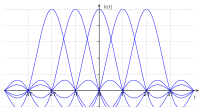
Photo from wikipedia
In this paper, a novel nonlinear companding transform (NCT) is proposed to reduce the Peak-to-Average Power Ratio (PAPR) of orthogonal frequency division multiplexing (OFDM) signals. The companding function is designed… Click to show full abstract
In this paper, a novel nonlinear companding transform (NCT) is proposed to reduce the Peak-to-Average Power Ratio (PAPR) of orthogonal frequency division multiplexing (OFDM) signals. The companding function is designed based on continuously differentiable reshaping of the probability density function (PDF) of signal amplitudes. The original PDF is cut off for PAPR reduction, and lower and medium segments of original PDF are scaled and linearized respectively, for maintaining power and cumulative distribution constraints. The linearized segment is set to be the tangent of the scaled version at the inflexion point, so as to reduce the out-of-band (OOB) radiation as much as possible. Parameters of the proposed scheme are solved under joint constraints of constant power and unity cumulative distribution. A new receiving method is also proposed to improve the bit error rate (BER) performance of OFDM systems. Simulation results indicate the proposed scheme can achieve better OOB radiation and BER performance at same PAPR levels, compared with existing similar companding algorithms.
Journal Title: China Communications
Year Published: 2020
Link to full text (if available)
Share on Social Media: Sign Up to like & get
recommendations!